|
|
|
Sort Order |
|
|
|
Items / Page
|
|
|
|
|
|
|
| Srl | Item |
| 1 |
ID:
139097
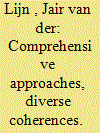

|
|
|
|
|
| Summary/Abstract |
Since 2000, international organisations such as the UN, NATO and the EU, but also countries, have started to apply what has been called the comprehensive approach to crisis management. This article unpacks this comprehensive approach implemented by the Dutch in Uruzgan province, Afghanistan. It first borrows and expands a conceptual framework developed by De Coning and Friis. Subsequently, it maps the different sorts of coherence in the mission by applying the framework. It shows how in practice there was not one single comprehensive approach, but many different forms of interaction between a number of organisational units. Each interaction had its own distinct issues and its own level of coherence. The level of coherence differed depending on the level at which the interaction took place – strategic at headquarters level versus operational at field level – and at what point in the mission it happened – in most cases it moved towards more cohesion.
|
|
|
|
|
|
|
|
|
|
|
|
|
|
|
|
| 2 |
ID:
139096
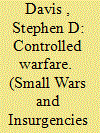

|
|
|
|
|
| Summary/Abstract |
US military operations are increasingly conducted within urban environments and with these operations come the risk of increasing the number of civilian casualties and infrastructure damage. The use of non-lethal weaponry, such as directed-energy weapons, is one method for minimizing collateral damage. This method enables US military forces to effectively fight within urban environments through force escalation capabilities. Using a series of historical examples and future scenarios for urban warfare, this article highlights deficiencies affecting military capabilities in military urban operations, addresses the consequences of collateral damage, assesses the effectiveness of directed-energy weapons in military urban operations and encourages further funding, research and integration of non-lethal weaponry, such as directed-energy weapons, within the US military.
|
|
|
|
|
|
|
|
|
|
|
|
|
|
|
|
| 3 |
ID:
139095
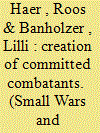

|
|
|
|
|
| Summary/Abstract |
Theories on conflict behaviour regard armed groups as unitary actors whose members faithfully execute the orders of their leaders. Nevertheless, in reality mutinies, insubordination and fractionalisation occur. We argue that the faithful execution of orders depends on the level of organisational commitment of combatants. This level can be increased with the help of four management strategies. Using a dataset based on fieldwork in the Democratic Republic of the Congo, we analyse the influence of each of these strategies. The Bayesian analyses show that recruitment, training and promotion has statistical reliable influence, but that providing rewards does not.
|
|
|
|
|
|
|
|
|
|
|
|
|
|
|
|
| 4 |
ID:
139094


|
|
|
|
|
| Summary/Abstract |
This article examines the term ‘assassination’ as describing a certain kind of killing which may – and does – occur in warfare. It critiques current definitions of the term to synthesise a stronger and more value-neutral definition: the premeditated killing of a specific individual in order to realise political objectives. It also critiques the term ‘targeted killing’ for a comparative lack of analytical clarity. The article then presents a theory of the goals assassination may achieve and the effects it may have on a conflict environment, when occurring within a military context. The article reviews three case studies which illustrate the scope of the theory, and concludes by noting that assassination can be the subject of legitimate ethical debate, as it may potentially adhere to the norms of Just War Theory, while constituting a valid category of military action.
|
|
|
|
|
|
|
|
|
|
|
|
|
|
|
|
| 5 |
ID:
139101
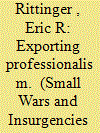

|
|
|
|
|
| Summary/Abstract |
Why did the United States, a country notorious for supporting coups and military dictatorships in Latin America during the Cold War, seek to depoliticize security forces in the Caribbean basin during the early twentieth century? Drawing from primary sources, I argue that this emphasis on military non-partisanship abroad stemmed from Progressive Era reforms popular at home. These reforms, which stressed bureaucratic efficiency via nonpartisan expertise, had become institutionalized within the US military and State Department and then channelled into the imperial administration of Nicaragua and the Dominican Republic. The State Department and Marine Corps attempted to replace local partisan armies with the kind of professional, nonpartisan armed forces that the US's own military had come to exemplify. That these civil-military reform efforts ultimately backfired should serve as a reminder of the difficulties inherent in using military interventions to transform coercive apparatuses and their societies.
|
|
|
|
|
|
|
|
|
|
|
|
|
|
|
|
| 6 |
ID:
139100
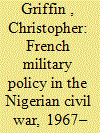

|
|
|
|
|
| Summary/Abstract |
During the Nigerian Civil War (1967–1970), France chose to support Biafra, but only on a limited scale, providing mercenaries and obsolete weaponry to Ojukwu's regime. General Charles de Gaulle's assistance to Ojukwu was conditioned by the French military drawdown after 1961, the increased power of French secret services on the continent, and the interventions in Katanga (1960–1963), Gabon (1964) and Chad (1968–1972). France supported Biafra primarily to protect its former colonies from Nigeria, stop Soviet subversion and acquire an economic foothold in the oil-rich Niger Delta. De Gaulle chose a limited strategy for two reasons. If Biafra won the war, France would be Biafra's greatest ally. If Nigeria won the war, France could extricate itself from the situation relatively easily and re-establish relations with the Nigerian government, which is what ultimately occurred.
|
|
|
|
|
|
|
|
|
|
|
|
|
|
|
|
| 7 |
ID:
139098
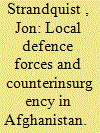

|
|
|
|
|
| Summary/Abstract |
This research note makes the case that if the US and its international allies are to successfully use ‘Local Defence Forces’ (LDF) to overcome counterinsurgency constraints in Afghanistan, current initiatives need to be significantly modified. A key issue is that the Village Stability Operations/Afghan Local Police (VSO/ALP) LDF program is unlikely to be effective in filling security gaps in rural Afghanistan because, much rhetoric to the contrary, it is essentially focused on militarily combating the insurgency rather than fully developing local communities as counterinsurgency resources by winning their support for the Afghan central government. The CIA's Village Defense Program in South Vietnam, a counterinsurgency program that has thus far received cursory attention in current LDF literature, provides a useful counterpoint. Through a comparison of the VDP and VSO/ALP operational patterns, implications are drawn for current and future US counterinsurgency practice employing LDF components.
|
|
|
|
|
|
|
|
|
|
|
|
|
|
|
|
| 8 |
ID:
139102
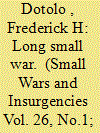

|
|
|
|
|
| Summary/Abstract |
The paper argues that the success of the Italian pacification campaign of Libya in 1932 can be traced to the implementation of a military-centric strategy used in counterrevolutionary warfare, a type of Small War made popular in the early twentieth century and an older form of counterinsurgency. Rather than focus on achieving an acceptable level of security common to modern counterinsurgency doctrine, COIN, the Italians used kinetic military operations to defeat and subdue rebel groups in the two Libyan colonies of Tripolitania and Cyrenaica. The roots of third rebellion, and the military strategy used to pacify the colonies, were developed during the guerrilla war by Ottoman and indigenous groups used to oppose the Italian invasion of Libya during the Italo-Libyan War, 1911–1912. The lessons of Italy's success should make the application of a military-centric rather than a security-centric strategy useful for current counterinsurgencies.
|
|
|
|
|
|
|
|
|
|
|
|
|
|
|
|
| 9 |
ID:
139103


|
|
|
|
|
| Summary/Abstract |
Although the environmental movement was established in the West, there is currently an Islamist variant that has received less attention. The Quran and the Hadiths provide guidance for the faithful on the relationship between Allah, humanity and nature. The article will examine and compare the environmental agendas of six Islamist groups: Hizb'allah, Hizb ut-Tahrir, Hamas, the Muslim Brotherhood, Jamaat-e-Islami, and al Qaeda. While they all share similar concerns, Islamists have developed globalized, glocalized, or localized ‘scales’ of engagement, depending on the targeted audience. Finally, the article will examine the security implications of Islamist environmentalism, including the possibility of an alliance between Islamists and militant environmentalists.
|
|
|
|
|
|
|
|
|
|
|
|
|
|
|
|
|
|
|
|
|